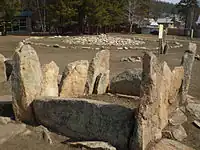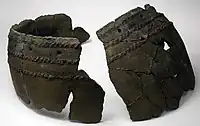Slab-grave culture
The Slab-Grave culture is an archaeological culture of Late Bronze Age and Early Iron Age Mongolia.[2][3] The Slab-Grave culture formed one of the primary ancestral components of the Xiongnu, as revealed by genetic evidence. The ethnogenesis of Turkic peoples and the modern Mongolian people is, at least partially, linked to the Slab-Grave culture by historical and archaeological evidence.[4][5] and further corroborated by genetic research on the Slab Grave remains.[6][7]
.png.webp)  -500 ◁ ▷ The Slab-grave culture and contemporary cultures c. 500 BC | |
| Geographical range | Mongolia |
|---|---|
| Period | Bronze Age, Iron Age |
| Dates | 1100–300 BC |
| Preceded by | Ulaanzuukh culture, Deer stones culture |
| Followed by | Xiongnu Empire |


The Slab-Grave culture is dated from 1100 to 300 BC. The origin of this slab-grave culture is not definitively known, however genetic evidence is consistent with multiple hypotheses of a local origin dating back to at least the Bronze Age.[8] In particular, the people of the Ulaanzuukh culture and the Slab Grave culture are closely associated with the Ancient Northeast Asians (ANA).[9] The genetic profiles of individuals from the Ulaanzukh LBA and the Slab Grave culture are identical, which is in agreement with the archaeological hypothesis that the Slab Grave culture emerged from the Ulaanzukh.[10]
To the west, the Slab-Grave culture was adjacent to, and essentially contemporaneous with, various Saka cultures such as the Tagar culture, the Pazyryk culture and the Aldy-Bel culture for a period of several centuries.[1] The Slab-Grave culture was superseded by the Xiongnu culture, which formed a vast empire stretching across much of the Eurasian world, and saw the hybridization of Western and Eastern Eurasian populations and cultures.
Area
Slab-grave cultural monuments are found in northern, central and eastern Mongolia, Inner Mongolia, Northwest China (Xinjiang region, Qilian Mountains etc.), Manchuria, Lesser Khingan, Buryatia, southern Irkutsk Oblast and southern and central Zabaykalsky Krai. The name of the culture is derived from the main typology of the graves, its graves have rectangular fences (chereksurs) of vertically set slabs of gneiss or granite, with stone kurgans inside the fence. Were found settlements, burial and ritual structures, rock paintings, deer stones, and other remains of that culture.
The most recent graves date from the 6th century BC, and the earliest monuments of the next in time Xiongnu culture belong to the 2nd century BC. The gap is not less than three centuries, and the monuments that would fill this chronological gap are almost unknown.
Burials
The slab graves are both individual and collective in groups of 5–8 to large burials with up to 350 fences. Large cemeteries have a clear plan. In Aga Buryat District were found more than three thousand fences. Most of the graves are burials, some are ritual fences – cenotaphs. Graves are oriented along west-east axis. Deceased are laid on the back, with the head to the east.
The fences vary from 1.5 m to 9.6 m, a height of the slabs vary from 0,5 m to 3 m. The grave pits under some kurgan mounds are covered with slabs that often are of considerable sizes. The depth of the burial pits vary from 0,6 m to 2,5–3 meters, in deep graves the side slabs were stacked and covered with several slab layers. In places within the fence sometimes were installed deer stones, single slabs with images of deer, less frequently of the horses, accompanied with solar signs and armaments.
A burial complex on the Lami mountain in the Nerchinsk area consisted of graves about 30 meters in length, divided into 4 sections. Not plundered fence was covered by several slabs each weighing up to 0,5 tons. Under cover slabs was an altar with skulls of horses, cows and sheep. Below were five burial chambers for inhumation.
Most of the graves were looted. The buried clothing and footwear is colorful, with various ornaments of bronze, bone and stone: plaques, buttons, necklaces, pendants, mirrors, cowrie shells. The accompanying tools are rare: Needles and needle beds, knives and axes-celts. Even less common are weapons: arrowheads, daggers, bow end caps. In some graves are horse harnesses, whip handles. There are bronze objects, fewer iron and precious metals.
Jars are round-bottom earthenware, some tripods. Vessel ornament are impressions, rolled bands, indentations. The art of the slab-grave culture belongs to the "animal style" art that depicts domesticated and wild animals, daily life and main occupations. The slab-grave culture art has many common features with cultures of Southern Siberia: Karasuk, Tagar, and others.
Graves in East Baikal
Thousands of graves can now be seen in the southern Baikal area. In some cases they form a cemetery, with a clear plan and a strict order. For example, at lake Balzino about a hundred graves formed circles and rectangles. They are usually located at higher elevation, exposed to sun. Monumental burials mark greatness of the people who once lived there. They became an integral part of the East Baikal steppes cultural and historical landscape.
 Slab grave. Exhibit in Ethnography Museum of E. Baikal peoples. Relocated from Horin region of Buryatia
Slab grave. Exhibit in Ethnography Museum of E. Baikal peoples. Relocated from Horin region of Buryatia Slab grave whetstone, Daram mountain, Eastern Mongolia.
Slab grave whetstone, Daram mountain, Eastern Mongolia. Slab grave stone beads, Mongolia
Slab grave stone beads, Mongolia Slab grave pottery, Narst, Bulgan, Northern Mongolia
Slab grave pottery, Narst, Bulgan, Northern Mongolia
Genetics
.png.webp)
Autosomal genetic evidence from several slab-grave fossils suggests that they were largely formed from Ancient Northeast Asian (ANA) populations.[11] However, uniparental genetic evidence suggests the slab-grave population had some West Eurasian ancestors.
As of 2022, all sequenced slab-grave males have been identified as belonging to East Eurasian paternal haplogroups.[12][13] On the other hand, slab-grave maternal lineages were more diverse, with 65-70% being of East Eurasian origin, while approximately 28-36% were of West Eurasian origin.[14][15]
East Eurasian maternal lineages in the slab-grave population can be easily traced to Transbaikalian neolithic agriculturalists. On the other hand, West Eurasian maternal lineages are believed to have complex origins, with many tracing back to ancient hunter gatherers who mixed with early agriculturalists in the early Holocene period, or to middle eastern agriculturalists who expanded eastward after the advent of sheep herding. Others could be linked to much later bronze age populations such as Afanasievo or Scythians. The complex diversity of West Eurasian ancestral lineages in the slab-grave population makes it difficult to pinpoint their exact origin.[16][17]
The transition from the slab-grave culture period to the Xiongnu period was characterized as a massive increase of West Eurasian paternal ancestry, rising from 0% to 46%, which was not accompanied by increased West Eurasian maternal ancestry. This is consistent with a violent expansion of males with West Eurasian paternal ancestry, or possibly marriage alliances that favored such people. According to Rogers and Kaestle (2022), these two scenarios are not necessarily mutually exclusive, but more data is needed to concisely explain why such an expansion took place.[18]
Paternal haplogroups
The predominant Y-DNA haplogroup in slab-grave males has been identified as Q1a.
See also
| History of Mongolia |
|---|
 |
Literature
- Borovka G.I., "Archaeological surveys of the river Tola", in the book: Northern Mongolia, Vol. 2, Leningrad, 1927;
- Dikov N.N., "Bronze Age in E.Baikal", Ulan-Ude, 1958
- Grishin S. "Bronze and early Iron Age of the E.Baikal, Moscow, 1975
- Konstantinov A.V., Konstantinova N.N. "History of E. Baikal (from ancient times to 1917)", Chita-2002.
- Kirillov O.I., Stavpetskaya M.N., "Religious and ritual structures of E.Baikal pastoralists in 1st millennia BC", //Young Archaeology and Ethnology oid Siberia, Chita, 1999, Vol. 1.
- Kiselev S.V., "Mongolia in ancient times", "Bulletin of USSR Akademy", Series History and Philosophy, 1947, Vol. 4
- Okladnikov A.P., Kirillov I.I., "South-East E.Baikal in the Stone Age and Early Bronze Age", Novosibirsk, 1980
- Tsibiktarov A.D. "Slab Grave Culture graves of Mongolia and E.Baikal", Ulan-Ude, 1998
- D. Tumen. Anthropology of Archaeological Populations from Northeast Asia :user.dankook.ac.kr/~oriental/Journal/pdf_new/49/11.pdf
References
- Gantulga, Jamiyan-Ombo (21 November 2020). "Ties between steppe and peninsula: Comparative perspective of the Bronze and Early Iron Ages of Мongolia and Кorea". Proceedings of the Mongolian Academy of Sciences: 65–88. doi:10.5564/pmas.v60i4.1507. ISSN 2312-2994. S2CID 234540665.
- Н.Наваан, Дорнод Монголын хүрлийн үе (Mongolian), N.Navaan, Bronze Age of Eastern Mongolia
- Tumen D., "Anthropology of Archaeological Populations from Northeast Asia page 25,27
- Vidaković, Nenad (30 April 2012). "From the Ethnic History of Asia – the Dōnghú, Wūhuán and Xiānbēi Proto-Mongolian Tribes". Migracijske i etničke teme (in Croatian). 28 (1): 75–95. ISSN 1333-2546. "Other types of sources on the history of the Proto-Mongolian tribes are archaeological findings, which associate Mongolian ethnogenesis with slab grave cultures and the Lower Xiàjiādiàn."
- Savelyev, Alexander; Jeong, Choongwon (2020-05-07). "Early nomads of the Eastern Steppe and their tentative connections in the West". Evolutionary Human Sciences. 2: E20. doi:10.1017/ehs.2020.18. ISSN 2513-843X. PMC 7612788. PMID 35663512.
- Jeong, Choongwon; Wang, Ke; Wilkin, Shevan; Taylor, William Timothy Treal; Miller, Bryan K.; Bemmann, Jan H.; Stahl, Raphaela; Chiovelli, Chelsea; Knolle, Florian; Ulziibayar, Sodnom; Khatanbaatar, Dorjpurev; Erdenebaatar, Diimaajav; Erdenebat, Ulambayar; Ochir, Ayudai; Ankhsanaa, Ganbold; Vanchigdash, Chuluunkhuu; Ochir, Battuga; Munkhbayar, Chuluunbat; Tumen, Dashzeveg; Kovalev, Alexey; Kradin, Nikolay; Bazarov, Bilikto A.; Miyagashev, Denis A.; Konovalov, Prokopiy B.; Zhambaltarova, Elena; Miller, Alicia Ventresca; Haak, Wolfgang; Schiffels, Stephan; Krause, Johannes; Boivin, Nicole; Erdene, Myagmar; Hendy, Jessica; Warinner, Christina (12 November 2020). "A Dynamic 6,000-Year Genetic History of Eurasia's Eastern Steppe". Cell. 183 (4): 890–904.e29. doi:10.1016/j.cell.2020.10.015. ISSN 1097-4172. PMC 7664836. PMID 33157037.
- Jeong, Choongwon; Wang, Ke; Wilkin, Shevan; Taylor, William Timothy Treal; Miller, Bryan K.; Bemmann, Jan H.; Stahl, Raphaela; Chiovelli, Chelsea; Knolle, Florian; Ulziibayar, Sodnom; Khatanbaatar, Dorjpurev; Erdenebaatar, Diimaajav; Erdenebat, Ulambayar; Ochir, Ayudai; Ankhsanaa, Ganbold (November 2020). "A Dynamic 6,000-Year Genetic History of Eurasia's Eastern Steppe". Cell. 183 (4): 890–904.e29. doi:10.1016/j.cell.2020.10.015. ISSN 0092-8674. PMC 7664836. PMID 33157037.
- Rogers, Leland Liu; Kaestle, Frederika Ann (April 2022). Analysis of mitochondrial DNA haplogroup frequencies in the population of the slab burial mortuary culture of Mongolia (ca. 1100–300 BCE ). pp. 644–657.
- Lee, Juhyeon (14 April 2023). "Genetic population structure of the Xiongnu Empire at imperial and local scales". Science Advances. 9 (15): eadf3904. doi:10.1126/sciadv.adf3904. ISSN 2375-2548. PMC 10104459.
Overall, individuals from the Ulaanzuukh and the Slab Grave cultures present a homogeneous genetic profile that has deep roots in the region and is referred to as Ancient Northeast Asian (ANA)
- Jeong, Choongwon; Wang, Ke; Wilkin, Shevan; Treal Taylor, William Timothy. "A Dynamic 6,000-Year Genetic History of Eurasia's Eastern Steppe". Cell.
- Jeong, Wang & Wilkin 2020
- Jeong, Choongwon; Wang, Ke; Wilkin, Shevan (12 November 2020). A Dynamic 6,000-Year Genetic History of Eurasia’s Eastern Steppe. pp. 890–904.e29.
- Rogers & Kaestle 2022: "While during the slab burial period (ca.1100–300 BCE) eastern patrilines seem to have been dominant..."
- Rogers & Kaestle 2022: "There are Y-chromosome data for only eight male slab burial individuals: four of which are from central Mongolia, two from the west central province of Khovsgol and two from the eastern regions, and all these individuals carry eastern Y-chromosome haplotypes (Jeong et al., 2020; Wang et al., 2020). While this sample is small, in comparison 28.57% of the mtDNA gene pool consisted of western hgs."
- Rogers & Kaestle 2022:The second pattern is that there is a moderate, but perceptible increase in western mtDNA haplotypes among the slab burial populations (SBA 28.57%: CSB 36%) compared with that of the Bronze Age of eastern Mongolia (BAMCE) (14.8%), while the western mtDNA component within the Xiongnu population remains extremely similar to that of the slab burial populations.
- Rogers & Kaestle 2022: "The mtDNA hgs of the eastern component of the slab burial population can be found in most northeast Asian populations and so can be safely assumed to be a local contribution to the slab burial gene pool. The “western” component is more difficult to source. "
- Rogers & Kaestle 2022:"The mtDNA hgs of the eastern component of the slab burial population can be found in most northeast Asian populations and so can be safely assumed to be a local contribution to the slab burial gene pool. The “western” component is more difficult to source. The K hg may represent an ancient addition from early western foragers that had intermixed with early agriculturalists (Spengler, 2015), similar with the probable origins of the C hg found in the ancient Ukraine (Nikitin et al., 2012). The J1c8a haplotype might be from a regional polymorphism that is linked to migrating populations after the expansion of agriculturalism from the Middle East, perhaps associated with the development of caprine pastoralism that reached southeast Kazakhstan by at least 2800 BCE (Hermes et al 2020). The H hg, more specifically the H2a5b* haplotype, is unlikely to have originated in Mongolia; based on coalescence times the H2a5b* most likely arrived on the Eastern Steppe near the beginning of the first millennia BCE. Besides the H2a5b haplotype, which must have arrived in a relatively recent migration, the remaining western hgs can be found already in place in Mongolia, although predominantly in the western regions...the well-documented expansion of the Afanasievo archaeological culture and the populations associated with the Pontic Steppe Scythians into Central Mongolia likely introduced many of these matrilines (Honeychurch et al., 2021; Järve et al., 2019)."
- Rogers & Kaestle 2022: "There are Y-chromosome data for only eight male slab burial individuals: four of which are from central Mongolia, two from the west central province of Khovsgol and two from the eastern regions, and all these individuals carry eastern Y-chromosome haplotypes (Jeong et al., 2020; Wang et al., 2020). While this sample is small, in comparison 28.57% of the mtDNA gene pool consisted of western hgs. By the Xiongnu period the male burial population (n = 32) carried 46.88% western Y-chromosome types with a total western mtDNA component of 27.59% (Jeong et al., 2020; Keyser-Tracqui et al., 2003; Wang et al., 2020). This suggests that by the beginning of the slab burial mortuary tradition, there had already been an east–west mixed population. While during the slab burial period (ca.1100–300 BCE) eastern patrilines seem to have been dominant, in the Xiongnu period about half of the population had western patrilines with virtually no change to the mtDNA gene pool in east–west terms. If sex bias migration patterns were similar with those found in Europe, this increase of western patrilines would be consistent with aggressive expansion of people with western male ancestry (Batini et al., 2017); however, such a pattern could also be due to a gradual nonaggressive assimilation, such as the practice of marriage alliances associated with an expansion of trade or cultural networks that favored people with western patrilines...During the Xiongnu period, there seemed to have been a major increase of western patrilines, mainly of R1a1 and J hgs; however, there does not seem to have been a major change in the mtDNA gene frequencies of the population overall.